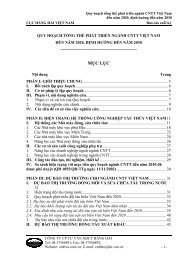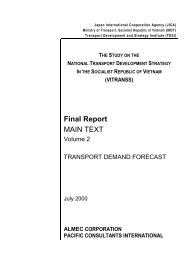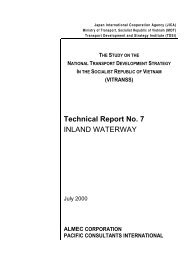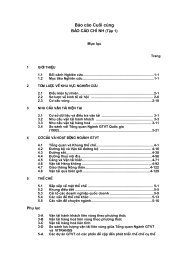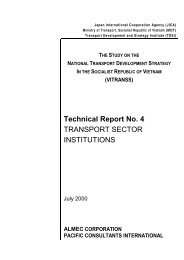Technical Report No. 8 PORT AND SHIPPING
Technical Report No. 8 PORT AND SHIPPING
Technical Report No. 8 PORT AND SHIPPING
Create successful ePaper yourself
Turn your PDF publications into a flip-book with our unique Google optimized e-Paper software.
II-3-3<br />
Vietnam National Transport Strategy Study (VITRANSS)<br />
<strong>Technical</strong> <strong>Report</strong> <strong>No</strong>. 8<br />
Shipping and Ports<br />
• In the north, Hai Phong port has functioned as a gateway port ever since its<br />
operation in 1876 with only a 60-meter long quay. Its physical nature as a river<br />
port, however, hardly allows large vessels of more than 7,000 DWT to dock.<br />
The port also requires substantial and continuous dredging works to maintain<br />
its access channel. Under such circumstances, Cai Lan port, 40 km northeast<br />
of Hai Phong, was proposed as an alternative deep-sea port in the first master<br />
plan done in 1970 by the USSR. After several revisions of the port<br />
development plan, three berths are now additionally being constructed to the<br />
existing single berth. In the course of planning, designing and construction,<br />
however, there is an increasing awareness to preserve the precious<br />
environment of Ha Long Bay.<br />
Headed by Hai Phong port, a local port network can be observed involving<br />
small river ports like Ninh Phuc, Hanoi, Viet Tri, and Nam Dinh. Industrial ports<br />
for coal, cement and oil are located separately along the coast and river.<br />
• In the central region, Danang port has functioned as a gateway port since the<br />
country’s unification. Its Tien Sa jetties can accommodate vessels with 30,000<br />
DWT. The existing facilities at Danang port are being expanded through the<br />
construction of a container pier (adjacent to the Tien Sa jetties). The port<br />
development, however, will have to overcome present problems like high<br />
waves, narrow cargo handling areas and a weak access road to the city<br />
center. Moreover, due to the small population and insufficient number of<br />
industrial establishments in the hinterland, the port’s throughput is far behind<br />
that of Hai Phong and Saigon ports.<br />
There are three more major seaports (i.e., Cua Lo, Qui Nhon and Nha Trang)<br />
dotting the long central coastline. With port improvement and/or additional<br />
infrastructure, these ports can receive vessels with 10,000 DWT throughout<br />
the year. However, the current traffic demand may not justify large<br />
investments in these ports. It needs industrial boom towns and<br />
transshipment/transit ports at many places, such as Vung Ang, Chan May,<br />
Lien Chieu, Dung Quat, Van Phong, etc., to generate sufficient traffic demand.<br />
Despite the present limited traffic demand, however, port development is very<br />
active in the region. When the regional economic crisis ends, it would be<br />
essential to carefully review the viability, timing and location of<br />
proposed/ongoing port projects in this area.<br />
• In the south, Saigon River is the busiest navigational route where numerous<br />
ports are located. It accommodates various kinds of vessels and barges up to<br />
20,000 DWT, which however is not enough for overseas shipping activities.<br />
Saigon port, established in 1860, is the most important port of the country.<br />
However, since it is located in the center of Ho Chi Minh City, it can hardly<br />
modernize due to narrow cargo-handling space on land and congested traffic<br />
in the city. Due to these factors, the Vung Tau-Thi Vai port area is becoming a<br />
crucial port.



